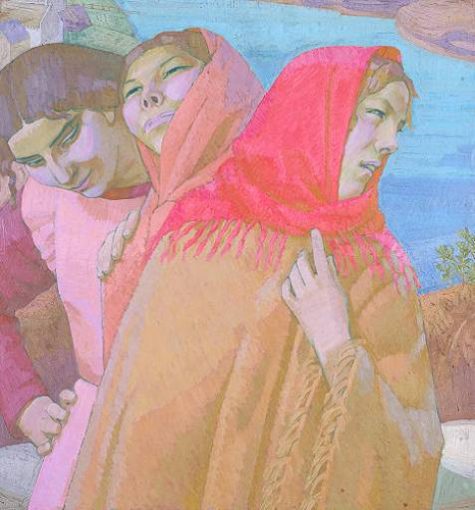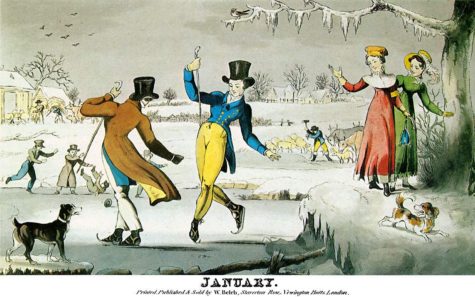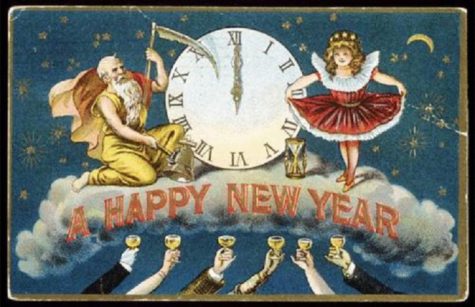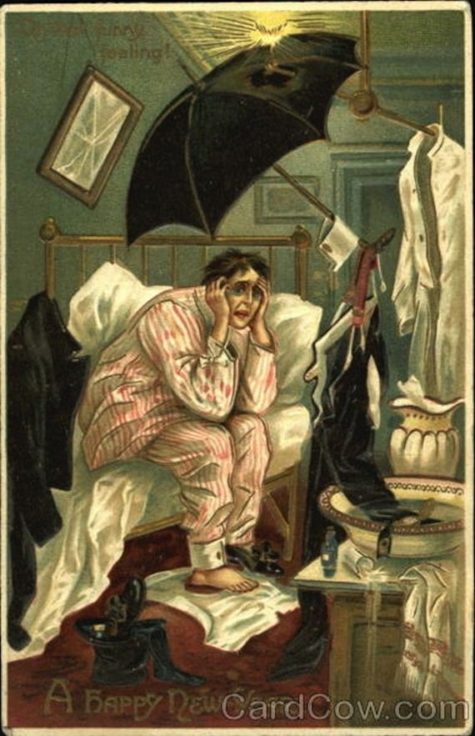Folklore
In April, the thunderstorms of March are beginning to subside, and the wind picks up. Seeds are being blown about on the breezes, spreading life all around from one place to the next. In fact, this month’s full moon is the aptly named Wind Moon, although in some traditions this lunar cycle is often known as the Seed Moon.
Trees have buds on them, spring daffodils and tulips abound, and the birds are nesting once more. Spring is well underway now that the soggy chill of March is past, and while it’s still soggy in a lot of places, there’s hope yet, because as the saying goes, those April showers will bring us flowers in May.
Now that April’s here, It’s a time to welcome new beginnings, and do magic related to conceiving new ideas and projects. Much like March, this is a time of conception and fertility and new growth. What do you want to see taking root and growing in your life?
Correspondences:
- Colors: Bright primary colors — red, yellow, blue — and their combinations
- Gemstones: Quartz, selenite, angelite
- Trees: Hazel, forsythia, lilac, willow
- Gods: Ishtar, Tawaret, Venus, Herne, Cernunnos
- Herbs: Dandelion, milkweed, dogwood, fennel, dill
- Element: Air
It’s the time to stop planning, and start doing. Take all those ideas you’ve had brewing for the past couple of months, and make them come to fruition. This is an excellent time to work on magic related to new beginnings. Looking to bring new love into your life, or conceive or adopt a child? This is the time to do those workings.
source:Paganwiccan
What follows is a list (in alphabetical order) of the names given to the April moon. Also listed is the tradition and/or origin of that moon name:
Ashes Moon ~Taos
Awakening Moon ~Neo Pagan
Big Leaves Moon ~Apache
Big Spring Moon ~Creek, Cree
Broken Snow Shoe Moon ~Anishnaabe
Budding Moon ~Mohawk
Corn Planting Moon ~Winnebago
Egg Moon ~Cherokee, Algonquin
Eostre Moon ~other
Fish Moon ~Algonquin
Flowers Moon ~Pomo, Cherokee
Frog Moon ~Assiniboine, Janic
Geese Egg Moon ~Cheyenne
Geese Return Moon ~Dakota
Grass Moon ~other
Gray Goose Moon ~Cree
Green Grass Moon ~Sioux
Growing Moon ~Celtic
Hare Moon ~other
Ice Breaking Moon ~Arapaho
Indian Corn Moon ~Algonquin
Leaf Moon ~Kiowa
Leaf Split Moon ~San Juan
Ostarmanoth Moon ~Old English
Pink Moon ~Algonquin
Planter’s Moon ~Colonial American, Algonquin
Red Grass Moon ~other
Seed Moon ~Medieval English
Sprouting Grass Moon ~Algonquin
Spring Moon ~Passamaquoddy
Strawberry Moon ~Natchez
Sugar Maker Moon ~Abernaki
Wildcat Moon ~Choctaw
Wind Breaks Moon ~Hopi
Yellow Moon ~Pima
April gets its name from the goddess Aprilis, who is the Romans’ version of Aphrodite. Her name means “to open,” which is exactly what Aprilis does… she opens the path to playfulness and the way to personal enrichment.
We all know the rhyme “April showers bring May flowers.” So consider what energies you want Aprilis to sprinkle on you this month for personal flowering. Overall, any magical efforts aimed toward growth, love, pleasure, improvements, and developing one’s inner child will benefit from working this month.
Because the Christian holiday of Easter sometimes falls in this month, the Anglo-Saxons and Franks called it Easter Month; of course, the word Easter comes originally from the name of the Pagan goddess Eostre, deity of Spring, fertiilty, and new life. The Romans called this month Aprilis, a time of unfolding leaves and flowers.
April was the second month of the Roman calendar, before January and February were added by King Numa Pompilius about 700 BC. It became the fourth month of the calendar year (the year when twelve months are displayed in order) during the time of the decemvirs about 450 BC, when it also was given 29 days April is commonly associated with the season of spring in the Northern hemisphere and autumn in the Southern hemisphere.
Correspondences for April:
- Nature Spirits: Plant faeries
- Herbs: Basil, chives, dragons blood, geranium, thistle
- Colors: Crimson red, gold
- Flowers: Daisy, sweetpea
- Scents: Pine, bay, bergamot, patchouli
- Stones: Ruby, garnet, sard
- Trees: Pine, bay, hazel
- Animals: Bear, wolf
- Birds: Hawk, magpie
- Deities: Kali, Hathor, Anahita, Ceres, Ishtar, Venus, Bast
- Birth stone: Diamond
- Birth flower: Daisy or sweet pea
- Zodiac Signs: Aries (until April 19) and Taurus (April 20 onwards).
Power Flow:
Energy into creating and producing; return balance to the nerves; change; self confidence; self reliance; take advantage of opportunities; work on temper and emotional flare-ups and selfishness.
April Festivities:
The Megalesia of Cybele, who was also known as Magna Mater (Great Mother) in both Phyrgia and Rome, celebrated the arrival of this goddess in Rome. In 204 BCE, Rome was in the midst of a great war with Hannibal. Things were going very badly for the Roman legions. Finally, the Romans sent a delegation to the Oracle at Delphi for an interpretation of their sacred Sibylline Books. This passage said that foreing invaders could only be driven away when the Mother of Mount Ida was transferred from Pessinus to Rome.
The oracle sent the delegation to the king of Pergamum in Asia Minor, where they were told that a black meteroite embodying the spirit of Cybele was. Pine trees from Mt. Ida, sacred to the goddess, were made into a ship, and the stone was transported from one sanctuary to another until it reached Rome. In about a year, Hannibal left Italy forever.
The Japanese Flower Festival has now become a celebration of Buddha’s birth. In the older celebration, however, the people gathered wildflowers for the family shrine. Those in the Shinto faith placed wooden markers on the graves and said prayers.
The Roman festival of Cerealia celebrated the return of Proserpina to the Earth goddess Ceres. Our word “cereal” comes from the name Ceres. It was the time of planting grain. Ceres was the Roman equivalent to the Greek goddess Demeter.The festival of Cerealia was held for seven days from mid-to-late April, but exact dates are uncertain.
Feriae Latinae was also held in April, with the date varying. Other ancient Roman observances include Veneralia, Fordicidia, Parilia, Vinalia Urbana, Robigalia, and Serapia.
The Egyptians called their land Khemennu, or Land of the Moon. Plutarch wrote that they believed the Moon to be the Mother of the Universe. Although the goddess Bast was primarily considered to be a deity of the gentle Sun, she was also connected with the Moon.
Floralia was held April 27 during the Republican era, or April 28 on the Julian calendar, and lasted until May 3. However, these dates do not correspond to the modern Gregorian calendar. The Floralia is still celebrated in many Central and Eastern European countries. It is a time to honor the goddess of flowers. People dress in gaily decorated costumes and wear flowers in their hair. Secretly delivering baskets of flowers on May Day is a remnant of this old festival.
During this month was also the Incan Ayrihua or Camay Inca Raymi, the Festival of the Inca.
April Weather Lore
It is said that if early April is foggy,
rain in June will make lanes boggy.
April weather:
rain and sunshine, both together.
April showers bring May flowers.
A dry April
Not the farmer’s will.
April wet
Is what he would get.
“If it rains on Easter Sunday,
it will rain on the next seven Sundays.”
More April Lore:
St George’s day is the twenty-third of the month; and St Mark’s Eve, with its superstition that the ghosts of those who are doomed to die within the year will be seen to pass into the church, falls on the twenty-fourth.
In China the symbolic ploughing of the earth by the emperor and princes of the blood took place in their third month, which frequently corresponds to April. In Finnish April is huhtikuu, meaning slash-and-burn moon, when gymnosperms for beat and burn clearing of farmland were felled.
In Slovene, the most established traditional name is mali traven, meaning the month when plants start growing.
The month Aprilis had 30 days; Numa Pompilius made it 29 days long; finally Julius Caesar’s calendar reform made it again 30 days long, which was not changed in the calendar revision of Augustus Caesar in 8 BC.
The Lyrids meteor shower appears on April 16-April 26 each year, with the peak generally occurring on April 22. Eta Aquariids meteor shower also appears in April. It is visible from about April 21 to about May 20 each year with peak activity on or around May 6. The Pi Puppids appear on April 23, but only in years around the parent comet’s perihelion date. The Virginids also shower at various dates in April.
The theme for April
The theme for April is momentum. When something has momentum it takes more of an effort to change its course, and less of an effort to move it in the direction it is already going. This is a tricky month as momentum will take hold in whatever direction you happen to be putting your focus and energy.
For example, if you are in a bad mood, that mood is in danger of gathering momentum. If you are focused on a creative project of your choosing, it will also gather momentum. It is very important that you are focused on the things you want in your life at this time for they are the ones that will gather momentum.
This is a highly creative and productive time. The challenge will be to stay directed and to have the discipline to move yourself out of situations and away from negativity that you would rather not be gathering momentum around. This will take discernment, the use of good boundaries and a commitment to some truth telling about what serves you and what does not.
If you find yourself in a downward spiral where everything seems to be falling apart in a big way, you may need to look at the truth of allowing something you have been holding onto to dissolve and leave your life. You may finally have the momentum to move yourself out of a situation that is not healthy or serving. On the other hand, a creative project that is aligned with spirit may have just been waiting for such a time to take off.
From:
- Moon Magick
- Lena Stevens, The Power Path
- Various other sources
This month was sacred to the Roman god Mars, hence the name March. Mars is similar to the Greek Ares, Tiu or Twaz of Central and Northern Europe, Teutates of the Celts, and Tyr of the Norse. The Roman goddess Bellona, goddess of war, had her special day during this month.
March is generally a blustery month weather-wise. The old weather saying “In like a lion, out like a lamb” is an apt description of March weather. For the Romans, it was the beginning of their year. The Spring Equinox, which falls around March 21 or 22, was a sacred and celebrated time in a great many world cultures. In the Southern Hemisphere, this would be equal to the Autumn Equinox, as the seasons are reversed. The Incas celebrated Pacha-puchy, or Earth Ripening, at this time.
The Roman Matronalia honored Juno Lucina, an aspect of the goddess Juno, who protected women, children and the family. Statues of the goddess were decorated with flowers, and special temple fires were lit. Girls made offerings to Juno Lucina at this time of year for happy and prosperous marriages.
The statue of Isis suckling her child symbolizes this goddess’s aspect as the Great Mother, the caretaker of the Earth and all life. Flowers were floated on the rivers and the boats blessed with incense.
In Canaan and other Semitic countries, the goddess Astarte was honored in a Spring celebration. Red eggs were given as gifts to family and friends, the beginning of our Easter egg tradition. Her sacred city of Byblos was noted for its extensive libraries before they were destroyed. As queen of heaven, Astarte wore crescent horns and was said to tirelessly create and destroy. The kings of Sidon ruled only with the goddess’s permission and called themselves the Priest of Astarte. Other cultures in the Middle East knew Astarte as Asherat of the Sea and Astart, queen of heaven.
Athene/Minerva,the armed goddess of wisdom,reigned over the biggest social event in Greece – the five day Spring competition featuring events in athletics, music, poetry and satire. Crowns of olive branches and flasks of olive oil were given to the winners of each event. On the final day, Athene’s birth was celebrated by draping the goddess’s statue in a new sacred garment.
This particular festival of Cybele, the Hilaria, was a happy time. Our word “hilarious” has similar word roots. The goddess Cybele can be compared to Demeter in many ways; Cybele represented the Earth as did Demeter and had a Spring resurrected son/lover Attis, who corresponded to Kore/Persephone. This happy festival celebrated the power of Cybele to overcome death.
Eostre was the German goddess of rebirth. Rabbits and colored eggs were fertility symbols connected with Her. Originally, Oestre was the goddess of the Spring Equinox whose name was changed to Easter by the Christians.
The Roman Luna, goddess of the Moon, was honored with the baking, exchanging, and eating of Moon cakes. Even the Chinese and Europeans knew of Moon cakes and some form of this goddess.
From: Moon Magick
Amaolikkervik Moon ~Inuit
Big Famine Moon ~Choctaw
Bud Moon ~Kiowa
Budding Trees Moon ~Medicine Wheel
Buffalo Calf Moon ~Arapaho, Sioux
Catching Fish Moon ~Agonquin
Chaste Moon ~Medieval English
Crow Moon ~Algonquin
Crane Moon ~Potawatomi
Crust Moon ~Algonquin
Deer Moon ~Natchez
Death Moon ~Neo-Pagan
Eagle Moon ~Cree
Fish Moon ~Colonial American
Green Moon ~Pima
Lenten Moon ~Cherokee
Little Frog Moon ~Omaha
Little Spring Moon ~Creek, Muscokee
Lizard Moon ~San Juan
Long Days Moon ~Wishram
Moon of Winds ~Celtic
Moose Hunter Moon ~Abenali
Much Lateness Moon ~Mohawk
Rain Moon ~Diegueno
Plow Moon ~Janic (full)
Sap Moon ~Algonquin
Seed Moon ~Janic (dark)
Snow Crust Moon ~Anishnaabe
Snow Sore Eyes Moon ~Dakota
Spring Moon ~Passamaquoddy
Strawberry ~Cherokee
Sugar Moon ~Algonquin
Whispering Wind Moon ~Hopi
Wind Strong Moon ~Taos
Windy Moon ~Cherokee
Worm Moon ~Algonquin
I found this account of Mother March in an old book about Bulgaria, published in 1877. I love the way they used to celebrate the month of March. It occurs to me that it might be fun and informative to watch the weather this month and assign certain days to certain people and see what happens.
The month of March, which falls in the Spring equinox is called by the Bulgarians, Baba Mart, Old Mother March, and is the only female month of the year, the others being considered as masculine. March in Bulgaria is like April in England, inconstant and capricious, alternating between storms and sunshine; and it is here specially dedicated to the fair sex, who during its continuance enjoy complete idleness, doing no work, and asserting a sort of temporary superiority over their husbands, which sometimes even goes to the length of administering a thrashing, without fear of reprisal.
In order not to displease Baba Mart, the women do not even smear the floors of their houses with clay (a work which is usually performed every week), wash, weave, or spin; for if they were to do so Baba Mart would give no rain during the year, and lightning would infallibly strike the house in which she had been thus insulted.
There are certain clever old women who, knowing where Baba Mart resides, pay her a visit, and from her information assign to each of the married women a day of the month on which the weather will be according to the character of the lady whose day it is; thus, if Mrs. Dimitri gets the 1st of March, it will be fine, with perhaps a warm and gentle shower or two, for she is an amiable and soft-hearted woman, a little give to shedding unnecessary tears upon any pretext. Mrs. Tanaz is a loud-voiced shrew, so her day will be made up of wind, black clouds, snow, and heavy rain. “Don’t go out shooting tomorrow, Chelibi, for it is the day of Kodja Keraz’s wife, and she has such an awful temper that the weather is sure to be horrible.”
When a woman is assigned a day for the first time, her character is judged by the state of the weather; fortunately this system is not extended to young ladies on their promotion, or many a match might be broken off by an inopportune storm in the month of March.
Found in: Twelve Years study of the Eastern Question in Bulgaria
What follows is a list (in alphabetical order) of the names given to the February moon. Also listed is the tradition and/or origin of that moon name:
- Avunnivik Moon ~Inuit
- Big Winter Moon ~other
- Bony Moon ~Cherokee
- Chaste Moon ~other
- Cleansing Moon ~other
- Coyote Frighten Moon ~San Juan
- Dark Storm Moon ~Janic
- Geese Moon ~Omaha
- Gray Moon ~Pima
- Horning Moon ~other
- Hunger Moon ~Janic, Algonquin
- Ice Moon ~Celtic
- Lateness Moon ~Mohawk
- Little Bud Moon ~Kiowa
- Little Famine Moon ~Choctaw
- Long Dry Moon ~Assiniboine
- Nuts Moon ~Natchez
- Old Moon ~Cree
- Purification Moon ~Hopi
- Running Fish Moon ~Winnebago
- Quickening Moon ~other
- Rabbit Moon ~Potawatomi
- Raccoon Moon ~Sioux
- Red Moon, ~other
- Shoulder Moon ~Wishram
- Snow Moon ~Neo-Pagan, Algonquin
- Solmonath Moon ~other
- Sparkling Frost Moon ~Arapaho
- Spruce Tips Moon ~Passamaquoddy
- Storm Moon ~Medieval English
- Sucker Moon ~Anishnaabe
- Trapper’s Moon ~Algonquin
- Trees Pop Moon ~Sioux
- Wild Moon ~other
- Wind Moon ~Creek
- Winter Moon ~Taos
- Wolf Moon ~other
The word January comes from the Roman name for this month; it was named after the god Janus who had two faces. This deity ruled over beginnings and endings, the past and future. Since January is reckoned as the first month of a new year, this connection with the god Janus is appropriate. It is an excellent time to work on putting aside the old and outdated in one’s personal life and making plans for new and better conditions.
Correspondences for January:
- Nature Spirits: gnomes, brownies
- Herbs: marjoram, holy thistle, nuts and cones
- Colors: brilliant white, blue-violet, black
- Flowers: snowdrop, crocus
- Scents: musk, mimosa
- Stones: garnet, onyx, jet, chrysoprase
- Trees: birch
- Animals: fox, coyote
- Birds: pheasant, blue jay
- Deities: Freyja, Inanna, Sarasvati, Hera, Ch’ang-O, Sinn
Power flow: sluggish; below the surface; A good time for spell work having to do with beginning and conceiving; protection; reversing spells; conserving energy by working on personal problems that involve no one else; getting your various bodies to work smoothly together for the same goals.
January Celebrations and Rituals:
The Chinese use the concept of putting aside the old and outdated in one’s personal life and making plans for new and better conditions in celebrating their New Year, which occurs on the first day of the New Moon when the Sun is in Aquarius. They considered this celebration a time for settling debts, honoring ancestors, and having family reunions. They carry paper images of dragons through the streets and set off fireworks to chase away evil entities and misfortune.
Tsao-Wang was the Chinese kitchen god or deity of the hearth and domestic comfort; his picture hung above the stove. He was the protector of the family and recorder of their actions and words. His report at the end of each year to the Heavenly Jade Emperor was said to determine the family’s coming fortune. Because of this, the Chinese burned the old picture-image and put up a new one a few days before New Year. His wife had the task of reporting on female family members.
Even the people of Tibet, whose year began about the end of January, had a celebration for expelling the Old Year. They made a dough image for the demons to inhabit, then worshiped them for seven days. At the end of that period, they took the image outside the village to a crossroad and abandoned it. The idea behind this seems to have been that the negative beings who had accumulated during the Old Year, received recognition for their existence, but also received a firm statement, by the action of leaving their image outside the village, that they were not welcome to hang around.
Most cultures had some ceremony for ending an old cycle of the calendar and celebrating the beginning of a new cycle. Physical activity acknowledging the end and beginning of cycles sets off similar changes in the subconscious mind. This change in the subconscious is necessary in order for actual physical changes to come about. Such rituals are helpful when one faces the end of cycles in relationships, career, residence, or other life situations.During the Feast of Kore, which was held at night with much feasting and dramatics, a group of initiates bearing torches went down into the goddess’s underground chamber. With much ceremony and reverence, they brought out the wooden statue of Kore, naked except for her golden jewelry. The statue was placed on a decorated litter and carried seven times around the temple. The Greeks considered that the number seven brought luck and success.
The Incan festival of Camay Quilla was held at the New Moon.
The Seven Deities of Luck in Japan were honored during a three-day festival called San-ga-nichi. To avoid good luck being swept away, there was no sweeping during this festival. These Seven Deities are also called Shichi Fukujin or Shichi-Kukujin, which means “Seven Gods of Happiness.” There are six gods and one goddess that make up this little group. They sail about in a treasure ship called a takarabune.
In Madagascar New Year’s is celebrated with much feasting and sacrificial killing of oxen takes place.
Chinese custom requires that every boy who calls on his neighbors or relatives on New Year’s day, should receive a couple of loose-skinned oranges, or he is considered shamefully treated. The name of orange means luck, fortune, and auspiciousness.
On New Year’s eve while the clock is striking twelve, repeat three times: “Good Saint Anne, good Saint Anne, send me a man as fast as you can,” and you will become engaged within a year.
At the beginning of the New Year in Natal, a ceremony is performed by the chief by spurting from his mouth a mixture of the New Year’s fruits in different directions as if upon his enemies. After this ceremony it is lawful for the people to eat the New Year’s fruits. They are only eaten by stealth before.
It was a custom of the Jews to serve up sheep’s head on New Year’s at their chief entertainment, as a mystical representation of the ram offered in sacrifice for Isaac. When a family or company sat down to this repast, each person took a piece of bread and dipping it in honey, said, “May this year be sweet and fruitful.”
In several parts of Belgium it is customary for the people to make waffles on New Year’s day. Around Liege the first waffle is crossformed or cut cross-wise, and placed on the chimney-piece as a New Year’s gift to the crucifix. It is believed that this waffle or cake is blessed; it does not rot and a small piece given to a sick man or beast makes them recover.
An old New Year’s custom which is still observed in some of the northern counties of England, is called “Going about with a vessel cup.” Poor women and girls desirous of obtaining charity take two dolls, representing the Virgin Mother and Infant Jesus, and go about from house to house during the week before New Year’s singing a quaint old carol and at its conclusion presenting for the receipt of alms a small cup, which is known as a “vessel cup.” To turn one of these vessel cup singers unrequited from your door is to forfeit all good health and good fortune for the approaching new year.
In Westmoreland and Cumberland early in the morning of New Year’s the “Taex Populi” assemble carrying stangs (long poles) and baskets. Every inhabitant or stranger who falls into the hands of this ruffian band will be sacrificed to their favorite Saint; a man is mounted on a stang, a woman is basketed, and carried shoulder high to the nearest balance and weighed. None are allowed to follow their accustomed occupations on this day.
In Guria in Asiatic Russia, the New Year is prepared for a month before the time comes; the people pen up poultry, turkeys, ducks and geese; but the chief animal for food is the pig which is fatted up a month before and killed two or three days before New Year’s. Continue reading
There is a lot of lore and superstition surrounding the New Year. What follows is an extensive listing of what NOT to do, and what to avoid at all costs on this most powerful day of the year:
- New Year’s day was one of ill omen to the ancient Egyptians.
- It is unlucky to have clothes hanging on the line when the New Year is born.
- If a person in deep mourning pays you a call on New Year’s day, a member of your family will die before the year is out.
- In Northern Yorkshire, people will not allow anyone to light a candle from the fire on New Year’s day, so afraid are they to “carry fire to fire.”
- The Chinese believe a Buddhist priest to be the first to enter a house on New Year’s morning is even worse than to have a woman first enter it.
- Burn all the visiting cards that have been received throughout the year on the first of January. If you keep them from year to year you will have bad luck.
- If you have not provided yourself with a calendar before the New Year comes in, you will be behindhand in all your undertakings during the year. (Massachusetts.)
- If you eat apples on New Year’s day it will produce abcesses.
- Some people believe that if you put on clean linen on New Year’s day, you will have sores come on your skin.
- On New Year’s day no one must utter the words that indicate death in any form, especially the word “shi” itself, lest the invitation be accepted. (Chinese.)
- The Chinese believe it very bad luck not to pay all of his outstanding accounts on the last day of the year, and begin fresh and straight on New Year’s day.
- If a creditor makes a disturbance in the house of a debtor on New Year’s Day it is considered a most unlucky omen for the future prosperity of the debtor. (China.)
- It is bad luck in China to spend money the first three days of the year, except for candies and refreshments.
- If one sneezes on New Year’s eve while preparing for bed, it is a sign of misfortune during the coming year. (China.)
- It is a sure sign of strife and debates among the learned, and of many robberies to happen during the year, if the new year is ushered in with very red clouds.
- A corpse in the house on New Year’s day is the sign of another death to follow soon.
- The throwing of coal-dust or soot instead of lime before a door on New Year’s day, betokens gloom and bad luck. (Malta.)
- When the wind blows on New Year’s night, it is a sign of pestilence.
- “If you wash clothes on New-Year’s day, you’ll be sure to wash a friend away.”
- It is unlucky to sow on New Year’s day.
- Spend on New Year, spend all the year.
- It is very unlucky to refuse a beggar anything on New Year’s day, or to refuse a request of any kind.
- A sudden noise on New Year’s night foretells the death of an inmate.
- To meet a priest before any other male on New Year’s day, is a sign of death during the year; if a policeman, litigation is sure to follow.
- It is unlucky to have a flat-footed person enter the house first of any one on New Year’s day. (Folk Lore of Northern Countries.)
- It is an omen of ill luck if a redhaired woman enters a house on New Year’s morning.
- If the first man you speak to on New Year’s morning has his hands in his pockets, you will have a hard time getting what money you want during the year.
- Among the Highlanders, if a black and threatening cloud appears on New Year’s eve, it is looked upon as a forerunner of some dire calamity to the country or to the family estate over which it appears to hang.
- French flax is put on the spindle New Year’s eve in many parts of Germany. None must be spun then, as it would be bad for the year’s spinning.
- It is unlucky to have the fire go out on New Year’s day.
- It is unlucky to eat anything green on New Year’s day.
- In Hesna, it is unlucky to eat an apple on New Year’s day.
- In the rural districts of Cornwall, it is unlucky, if a female is the first to enter a house on New Year’s morning.
- In some of the northern countries of Scotland, it is considered unlucky to enter a person’s house on New Year’s day empty.
- In Scotland, nothing that could be washed on the last night of the year was left unclean. Even the walls were whitewashed inside, lest misfortune should fall upon the family.
- To break a white lamp-globe on New Year’s day is a sure sign that you will experience great financial losses during the year.
- To break a colored lamp-globe on New Year’s day is a sign of the death of a near relative during the year.
- The Chinese think it unlucky to allude to any possible misfortune on New Year’s day.
- It is unlucky to take ashes out of the house on New Year’s day.
And last but not least:
In Malta, a superstitious dread still attaches to some one of the family keeping absent at dinner time on New Year’s day. He who doesn’t dine with his family on New Year’s day is expected to die at the end of that same year. It is also said in Malta that he who eats hotch-potch soup on New Year’s day is to gnaw the ham bones all the rest of the year; and that those who eat cabbage on New Year’s day will groan for a whole year.

















